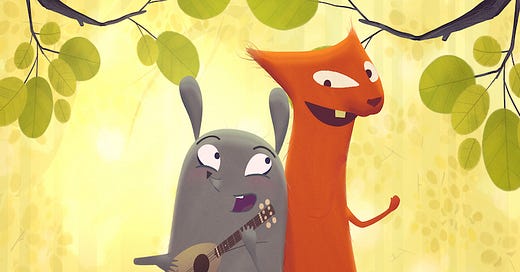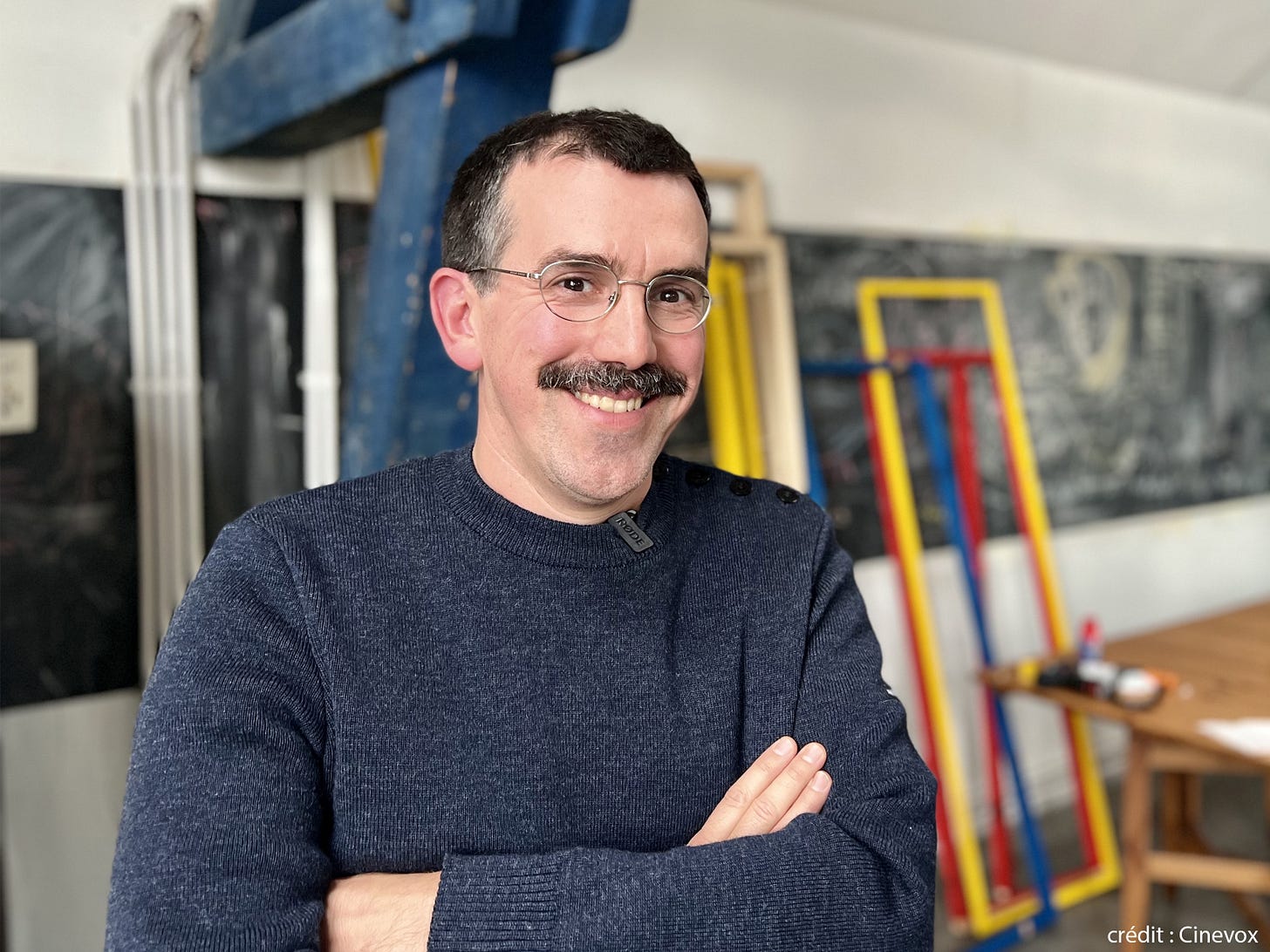"Above all, I love the idea of crafting a shot and making images move": Rémi Durin on His Feature Debut 'Yuku and the Flowers of the Himalayas'
And a few notes from the Belgian press scene, and why it's more important than ever to keep sharing this newsletter today.
While Belgian talented artists and studios often collaborate internationally on many features, there has been only a few animated Belgian feature films released in the last decade.
We’ve already discussed why with members of the industry, yet there are a few adventurers who dare to cross the bridge between shorts and feature.
In 2022, producer/director/author Arnaud Demuynck and animator/director/studio founder Rémi Durin made that leap with Yuku and the Flower of the Himalayas, and the success of the film exceeded their very own dreams.
But first, hello everyone and welcome to the Animation Belgian!
As I came back from Annecy with still stars in my eyes, bringing back a consistent weekly newsletter about Belgian animation has been on the top of my mind. And then, life happened.
We had to wrap-up our 24th issue of Surimpressions, the publication I manage here in Belgium, and production week is always kind of maëlstrom. And just as I was about to dive back into this animated project, a new client — 3DVF — offered me the opportunity to write not one, not two, but forty papers on animation in the upcoming month.
Needless to say I’m ecstatic, and a little bit stressed. But I do cherish that chance to write that much about animation, in a Belgian setting where culture gets less and less slots in the press.
Recently, many of my freelance colleagues were let go by L’Avenir, and the upcoming fusion between media giants Rossel and IPM will create a never-before-seen monopoly in the French-speaking Belgian press. With — you guessed it — even less space for culture, and I’m not even talking about animated cinema.
It’s because of these few possibilities that I started this project, and this dire situation fuels me with the will to push it further.
So, without further ado, let’s dive into the makings of Yuku and the Flower of the Himalayas, with co-director Rémi Durin, who welcomed me and my colleague from Cinergie back in 2022 for a lovely interview.
To begin this interview, could you tell us a little about your animated journey so far?
My name is Rémi Durin, I am the co-founder of Studio l’Enclume along with Jérémie Mazurek and Paul Jadoul. Studio l’Enclume started as a collective to support each other.
Little by little, we became a real studio, and we were able to develop our own projects in turn, working on each other shorts. With Yuku, we are releasing our first feature film, and it so happens that it was my turn.
What drives you in your work as a filmmaker?
What I really like are drawings. I'm quite instinctive, and I love everything to do with graphics and illustration. Children's books and comics are worlds that speak to me, and I love seeing them move, hear them through sounds, and be told in animated form. Of course, good stories are important, but above all, I love the idea of crafting a shot and making images move. There's something so simple and yet magical about it at the same time.
How did you became involved in this project?
Arnaud Demuynck is the one behind this film. We had been working together for almost fifteen years, and he produced my first short film So Close, back in 2009. I’d say we're kind of traveling companions.
He's also the one who came up with this musical project, with his universe and his ideas. Studio L'Enclume and our team came along later to respond to something he had thought of, imagined, and proposed to us.
From there, we created a trio with Paul Jadoul, who took on the role of artistic director, and we were able to compare our vision to Arnaud's, exchange ideas, and agree to create a joint work. It wasn't always without disagreement, but that's also what collaboration is all about.
As a director, how did you go from short to feature film?
Actually, you don't really go there. At that time, we had only made medium-length or short films up, and for Yuku we approached the project as a very ambitious short film.
Looking back, I think it was both out of amateurism and a desire not to put too much pressure on ourselves, but we chose to maintain an artisanal process, a very personal way of working.
When the film grew and we began collaborating with the Swiss and French teams, we had to get organized, but all the while trying to maintain a relaxed attitude.
In my experience, one does not really prepare for making a feature film, it’s a bit like having children [laughs]. You learn on the job, with bad but also good surprises.
In Yuku, you use both 2D and 3D animation, what drove you to this aesthetic choice?
It was first and foremost a technical decision. Paul, whose universe is more drawn from illustration, works in two dimensions. He uses very particular colors, flat tints, paint projections, in short, something very graphic.
At the same time, for the feasibility of the film, we wanted to experiment with ways of working that would allow us to have a good balance between quality and budget. Paul developed a technique that allowed him to integrate his universe and his colors into 3D animation, with this idea of pushing the software to its limits, aiming to always return more to an illustrative graphic design.
We achieved that by working around shadows, characters, without letting the 3D “take over”. This was a long process, with many experiments.
As I understand it, you acted as sort of a conductor between those different teams?
That's where you learn a lot. My responsibility was initially the staging, but the entire film actually flows from there. It's not just about translating a script into a storyboard, it's also about coming up with ideas that will give meaning and interest to the scenes.It's not a job you do alone, and I was lucky to have a team of a few people around me who helped me carry out this important, and sometimes exhausting, work. At that level and in that position, you have to be able to admit that you're not great all the time, and sharing the work allows you to test ideas, respond to each other, and achieve an optimal result.
For the musical sequences, for example, we collaborated with the Breton studio Vivement Lundi! and a director specialized in this type of scene, where I felt a little less comfortable.
For a story to be well told, you have to find a way to tell each scene with real interest, with a context that also tells something about the film. And not just a simple shot-reverse shot. In what setting will it take place? With what color palettes? The job of directing is to draw on good ideas to find the best ways to tell the story. That's what creates the whole.
What does it mean to make animated films in Belgium today?
If you want to make a film of a certain scale in 2022, you have to share the work and the budgets. Working in synergy with other national and international actors is an almost structural aspect of our way of working.
There simply isn't enough funding in Belgium to produce solo, which leads us from the very beginning of the project to think about who we're going to share the project with, and how. That’s when collaborations are born.
With our experience, we had the advantage of already having privileged contacts, studios with whom we'd been able to build a relationship of trust. This was the case with Nadasdy Film in Switzerland. But this search for funding also allowed us to collaborate with new partners like Vivement Lundi!, and to meet great people.
In this process, we mustn't be afraid to be curious, and to approach companies that speak to us, that inspire us. Working this way helps avoid frustrations from the outset, and everything went very well, in the interest of the film.
A beautiful result, tackling a hard subject in a very touching way.
That's true, but I think it's important to talk to children about things that aren't always joyful. In fact, they're already thinking about them without us. The idea of death, the loss of a loved one, the idea of mourning, it's a bit abstract when you're four, six, eight years old.
Proposing a film that takes the lead, that explains that, whatever happens, we will all die in the end, is also about preparing the child rather than lying to them to protect them. We wanted to be able to deal with death without hiding it, to be able to talk about it. All children have these questions, and it's good to discuss them. There is no miracle flower in Yuku, because there isn't one in life.
But it's not a fatalistic observation; we're not hiding anything from the audience. Death is something sad, certainly, but also natural. And it was important for us that the film reflect this reality.
Even three years after this interview, I was still very touched by Rémi’s honesty, and it does make me want to go back to that piece.
You can rent or buy Yuku and the Flower of the Himalayas on Arte.tv here, and I leave with you with the films’ trailer, a joyous and feel good experience perfect to start your Friday.
Have a great animated weekend,
Kevin









